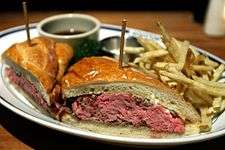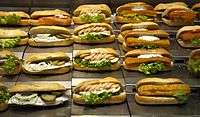Choripán
 | |
| Type | Sandwich |
|---|---|
| Place of origin | Rio de la Plata region (Argentina)[1] |
| Main ingredients | Crusty bread (marraqueta or baguette), chorizo |
Choripán (plural: choripanes) is a type of sandwich with chorizo, popular in Argentina and Uruguay. The name comes from the combination of the names of its ingredients: a grilled chorizo (sausage) and a pan (crusty bread) such as a marraqueta or baguette.[2][3]
In various countries


Argentina
The Argentine choripán consists of a sausage made out of beef and and Superpanchos - Argentine Fast Food is Slow Grilled”]</ref> The chorizo may be used whole or cut in half lengthwise, in which case it is called a mariposa (butterfly). It is customary to add sauces on the bread, most likely chimichurri.
Choripanes are commonly served as an appetizer during the preparation of an asado, but they are also very commonly sold at sport venues (particularly football games) and on the sides of roads and streets in major cities in Argentina. Taxi cab drivers in Buenos Aires are avid consumers and some street sellers can gather a long line of cabs during lunch time and afternoons when drivers get their lunch break.
Brazil
There are several Brazilian versions of choripán, the one most resembling the Argentinian version is called salchipão, and made, in southern Brazil, with "French bread" (a Brazilian-style baguette-like small roll) and pork sausage. It is often served as an appetizer during the preparation of a churrasco, or even as a substitute for barbecues, because salchipães are much cheaper, easier and quicker to make - so, they can be prepared on a short notice. Elsewhere in the country, there are many variations on the popular sanduíche de linguiça (literally "sausage sandwich"), most also made with Pão francês (lit. "French bread", a Brazilian baguette-like small roll) and pork sausage, but other breads and sausages can also be found. Possible additions to the basic recipe include melted cheese, requeijão, sautéed onions, vinaigrette sauce, shoestring potatoes, mustard, hot sauce and many others. It is usually served as a casual meal, perhaps with a cold beer, very popularly on road-side dinners.
Chile
In Chile, choripanes are very popular, particularly consumed as a classic appetizer during asados. Traditionally served in marraqueta and topped with aji and pebre, also mayonnaise is commonly used. Chilean choripanes are also made with longanizas instead of chorizos.
Puerto Rico
Usually sold in bakeries ("panaderías"), they consist of a Spanish-style chorizo such as chistorra or cantimpalo, pickles and mayonnaise inside a typical home made Puerto Rican bread called "pan de agua". Other ingredients may be added, Manchego cheese and ketchup being popular ones.
Uruguay
The chorizo is sausage made of pork, may be used whole or cut in half lengthwise. Usually the sauce chimichurri is used as well as mayonnaise, sometimes Uruguayans tend to add tomatoes and lettuce. It's served in baguette or in "pan catalán" (sliced soft bread roll), except in football matches where is served in simple bread roll or bun (like hamburguers). Unlike in Argentina, chorizo is not only used as an appetizer but also as a garnish for the asado.
U.S.
In the U.S., they are commonly available at lunch counters in Miami's Cuban diners and cafes, where the sandwich is customarily served on Cuban bread and topped with raw or fried onion and popularly eaten with a tropical fruit shake.
Notes
- ↑ http://www.vidapositiva.com/Con-ustedes-El-choripan.html
- ↑ Real Academia Española. Choripán.
- ↑ "El papel del traductor en una sociedad diglósica". Norah Marcela Azúa. Retrieved 16 June 2010.
Further reading
| Wikimedia Commons has media related to Choripán. |
- Connelly, Michael Alan (December 18, 2014). "20 Must-Try Street Foods Around the World". Fodor's. Retrieved July 24, 2016.

